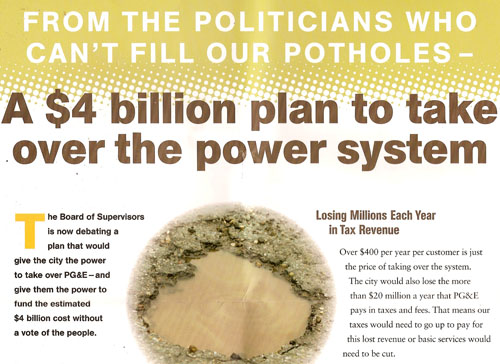By Luke Thomas
July 18, 2008
Supervisor Ross Mirkarimi today slammed PG&E for its attempt to “scare” San Francisco residents into rejecting a November ballot initiative that would transform the city’s energy policy.
“It’s shameful and it’s just so signature classic PG&E,” Mirkarimi said, referring to a PG&E campaign mailer distributed citywide to registered voters. “What they are doing is to try to scare San Franciscans to then scare their Supervisors” to vote against a charter amendment that would authorize the City to conduct a renewable energy feasibility study.
Dubbed the San Francisco Clean Energy Act, the legislation, if deemed feasible by the San Francisco Public Utilities Commission, seeks to incrementally achieve a 100 percent renewable clean energy portfolio by 2040.
“They are literally scared from the feasibility study because they know that San Francisco will best be suited for charting its own energy destiny,” Mirkarimi said.
PG&E’s mailer contends such a move would cost residents over $4 billion to “take over PG&E” and would not guarantee lower energy costs.

Mirkarimi disputes PG&E’s assessment citing lower energy costs have been achieved in over 900 U.S. municipalities that have converted from private to municipal utilities.
“Here’s one undeniable fact,” Mirkarimi said. “Of the nine hundred cities in the United States that are public power cities… every one of them shows that they delivered cheaper electricity, and better, than the private utility.”
Citing a recent speech by former Vice President Al Gore, Mirkarimi said the U.S. can achieve a 100 percent renewable energy portfolio within ten years but warned private interests, like PG&E, would oppose such efforts.



 The Hunger Site
The Hunger Site
August 6, 2008 at 3:10 pm
Gino, Mirkarimi’s Clean Energy Act charter amendment does pursue clean energy by proposing 100% renewable energy. However, this is only a portion of his long-term plan to solve San Francisco’s energy crisis.
In regards to “PG&Es†take over, Mirkarimi is interested in the feasibility of a publicly owned utility. Only a proposal, Mirkarimi suggests the city to fund a research and act on the behalf of the public. There are thousands of cities in the united states that are publicly owned (are not served by an utility company such as PG&E) and have done very well. In fact, a public utility may potentially bring revenues to the city, lower electric rates and serve as investment to the city.
Mirkarimi’s third major amendment would attract and mandate a green collar workforce. Jobs will be needed to install and maintain renewable generation systems, and run the public utility.
The greatest challenge will be to offer people a true view of his proposal. Opposing parties have given a whole new meaning to his amendment and will continue to advertise for their own interest. My hope is that individuals do invest time in pursuing more than one source of information before voting in November.
July 22, 2008 at 11:37 am
From this quote.
“Problem is, apparently it is illegal to use a company’s investor financial statements to assess them for taxation purposes.”
I am curious, what caused this law to go into effect? What are the reasonings for it?
What is most worrysome, is that when you hear PG&E speak, it is as though they are not trying. During hearings, and public comment.
July 20, 2008 at 10:33 am
Great point, Karen, about PG&E’s assets in SF. This is common practice among large corporations especially…they claim their assets are x when the taxman cometh, and claim their assets are y to their investors. They always tell their investors they are worth more than they tell the tax assessors. Problem is, apparently it is illegal to use a company’s investor financial statements to assess them for taxation purposes.
July 20, 2008 at 12:10 am
As a journalist, I am deeply troubled by the fact that many news outlets are parroting PG&E’s lie that the city wants to “take over” the company. If reporters, editorial writers and editors read the charter amendment, they would see that it is intended to steer San Francisco toward using clean, renewable energy sources and that nowhere does it mandate acquisition of PG&E or any of its assets.
And while opponents of the amendment speak the truth when they note that public transit service here is far from ideal, they forget to mention that there are some services that the city provides quite capably. One of those is water delivery, which is the province of the Public Utilities Commission — which is important, because it is the SFPUC, not the Municipal Railway, that will be responsible for mapping the city’s energy-sourcing strategy if the charter amendment passes.
July 19, 2008 at 6:20 pm
What really kills me about this mailer is its reference to a “$4 billion plan to take over the power system.”
If the following is true, how are they getting to $4B?
“…the California State Board of Equalization says all of PG&E’s state-assessed San Francisco property was worth $1.2 billion in 2007. The board’s appraisers assess PG&E’s property for tax purposes and their final figure includes millions of dollars of property that San Francisco would not want to own (including their downtown office complex).” (Witherell in SFBG, 7/2/08)
Last I checked, just repeating something over and over (5 times in this mailer alone) doesn’t make it true.
July 19, 2008 at 7:30 am
Usually, I recycle the propaganda, but I kept this piece for the archives. I’m glad Ross came out swiftly on it.
We could probably fill a few more potholes, if we hadn’t been so busy guilding city hall dome.